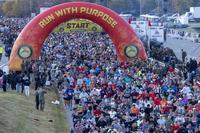If you are new to swimming and preparing for military swimming tests, you will encounter situations that have you guessing distances and times, depending on the pools where you practice and take the test.
Some pools are built in meters and others in yards. To add to the confusion, the military uses both units of measure. For instance, the Navy tests its swims in yards (500-yard swim test), and the Air Force and Marines test in meters (500-meter swim test). Depending on the pool used to test these events, you may have to calculate meters to yards or vice versa. Add a long 50-meter or 50-yard pool to the equation when you are used to swimming in 25-meter or 25-yard pools, and the confusion continues.
Here is a logical question from a non-swimming athlete preparing for the swim test in the military:
Stew, I've been swimming in 25-yard pools for my training. I heard my local military base has a 50-meter pool where we test the Navy PST [Physical Screening Test]. Any advice on the difference between training small and testing big? Thanks, Alex
Alex, that's a great question. Over the years, I have seen many people confuse the two units or not consider the difference when timing their swim. It is nice if you have been training in a meter pool and do not realize it and then test in a yard pool for the first time. People typically see a minute faster time when doing the Combat Swimmer Stroke in the Navy PST.
Distance
The distance of your test will be the same, regardless of the pool length, unless the people administering the test make a mistake on the actual pool size or in the conversion from yards to meters. The important thing to remember is that there are roughly 450 meters in 500 yards. In a short-meter pool, you would swim 18 lengths of the pool (nine laps) instead of 20 lengths/10 laps compared to a yard pool. The long course is the same, but you will swim nine lengths in the 50-meter pool to get 450 meters/500 yards and 10 lengths if in a 50-yard pool.
The more difficult and opposite conversion is required if you take the 500-meter swim of the Air Force or Marine Corps (Recon) in a yard pool. Now, you will have to swim 546 yards to get 500 meters. Some instructors will have you start 4 yards off the wall and swim 22 lengths in a 25-yard pool to get the additional 46 yards by adding almost an extra lap. Now, you see the confusion.
Speed
Anytime you swim in a shorter pool, you get more kicks off the wall. This underwater section of the swim makes you faster. Though you may be more winded from the extra breath holds, people typically are 20-30 seconds faster in a 25-yard pool vs. a 50-yard swim, especially if doing the CSS. In fact, in a shorter pool, most swimmers are underwater for nearly 50%-60% of the distance, whereas on a long course, you are underwater 25%-30% of the time. Swimmers, like submarines, are always faster underwater after a kickoff of the wall. With fewer wall kicks, we are just slower, but not by too much.
Make Up Time with Better Swim Gear
Many non-swimmers swim in shorts. These athletes train and test in these bulkier shorts, from gym shorts to board shorts. If you want to invest in tighter-fitting shorts, get a pair of "jammers" -- similar to biker shorts. I have seen people drop 20-30 seconds off their 500-yard or 500-meter swim just by making this change. If you do this, you can make up for the extra time on the longer course and not be affected by the change in pool size.
If you can, consider training in a long (50-meter or 50-yard) pool, as it will get you in better swimming shape, especially when you start to add swimming with scuba fins to graduate these military spec ops selections. Double-check the dimensions of the pool as well and plan your swim workouts accordingly. If no one knows the pool length, either bring a tape measure or check for any pool records that will be recorded in the pool units.
Stew Smith is a former Navy SEAL and fitness author certified as a Strength and Conditioning Specialist (CSCS) with the National Strength and Conditioning Association. Visit his Fitness eBook store if you're looking to start a workout program to create a healthy lifestyle. Send your fitness questions to stew@stewsmith.com.
Want to Learn More About Military Life?
Whether you're thinking of joining the military, looking for fitness and basic training tips, or keeping up with military life and benefits, Military.com has you covered. Subscribe to Military.com to have military news, updates and resources delivered directly to your inbox.


















